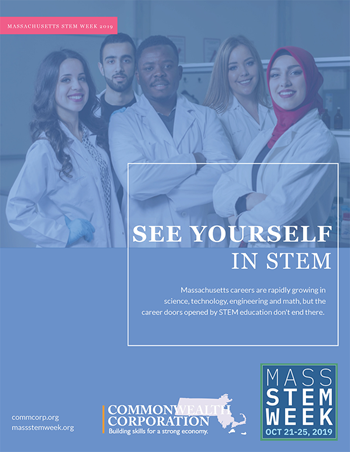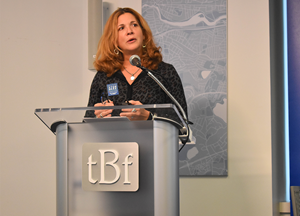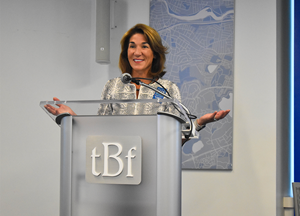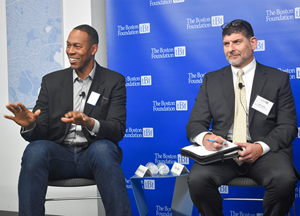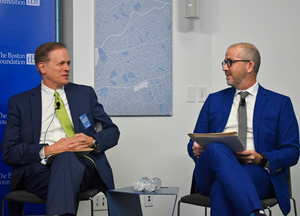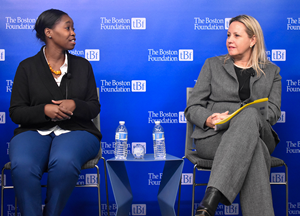The Importance of STEM Education
A Boston Foundation event highlights the opportunities and imbalances in Massachusetts STEM workforce
October 28, 2019
October 25th may have been the last official day of Mass STEM Week 2019, but if the expert speakers at a Boston Foundation forum on October 24 had their way, every week would be STEM Week.
On hand in the Edgerley Center for Civic Leadership at the Foundation were practitioners, advocates and policy makers, who, after opening remarks by Lieutenant Govern Karyn Polito, shared research and engaged in conversation on the event’s theme: “The Importance of STEM Education.”
In short, the importance is twofold: For the individual, quality science, technology, engineering and mathematics (STEM) education opens doors to livable- and high-wage jobs; for the broader community, that education guarantees a reliable talent pipeline to continue fueling our innovation economy.
It sounds simple, but it requires us to get out of some of our old habits of mind or organizational structures in order to ensure that today’s (and tomorrow’s) STEM education is appropriate, available and affordable to all students.
Rosalin Acosta, Secretary of Labor & Workforce Development for the Commonwealth, presented some top line data from a new Commonwealth Corporation report to illustrate why we need to change minds and structures. Today, she noted, STEM workers make up 17 percent of the Massachusetts workforce – and growing – the opportunities are not evenly shared:
- Women make up almost half of STEM workers, but women STEM workers are skewed toward lower paying health work, and are outnumbered 3-to-1 in computer and mathematical sciences, and 6-to-1 in architecture and engineering.
- There’s also a pipeline problem. Women make up just 18% of engineering/architecture degree holders and 30% of computer science degree holders – and the women with those degrees are less likely to pursue careers in their field.
- Latinos, who make up nearly 9% of Mass. workers, are underrepresented in all STEM fields and African-Americans are underrepresented in all fields but health care.
- And Massachusetts’ STEM economy relies on immigrant workers - one quarter of Massachusetts STEM workers are foreign-born, versus 19 percent in country overall.
Boston Foundation Vice President of Communications & Public Affairs Keith Mahoney moderated the subsequent discussion, probing into challenges, successes and new approaches with five panelists steeped in STEM:
- Carolina Alarco, Founder & Principal of BioStrategy Advisors
- Eric Conti, Superintendent of Burlington Public Schools
- Jackney Prioly Joseph, Director, Career Readiness Initiatives, at Massachusetts Business Alliance for Education
- Travis McCready, President & CEO of the Massachusetts Life Sciences Center
- James Peyser, Secretary of Education for the Commonwealth of Massachusetts
The conversation repeatedly turned to the subject of “pathways,” defined routes for young people to envision, pursue and get into careers in STEM fields or, importantly, into STEM-related careers in other fields. Historically, that pathway to a high-paying STEM career meant high school, college and often an advanced degree—a slow process with high opportunity costs including deferred earnings, and often strewn with more subtle barriers to entry, be they bias, language, unstated expectations or others.
Until we expand the pathways to entry, McCready noted, we will leave out large swaths of workers. “How do we find ways to plug each other and our kids into opportunities in every walk of life? Sometimes it means advanced degree pathways but [focus on that] obscures the skill pathway. Every job requires skill, not necessarily a degree,” McCready said. “We need to map pathways to individual’s desires, visions and ambitions.”
All the panelists were involved in some way in envisioning, developing and funding creative new pathways. For example, “early college,” in which students can take for-credit community college courses while in high school, can encourage ambitious students, expose first generation students to the rigors of undergraduate work from the safety of their public school, and significantly reduce the cost and time to earn a degree. The Commonwealth Commitment is a state sponsored community college to university pathway that Secretary Peyser described, which guarantees admission and caps costs at the state’s four-year universities for students who work first toward an associate’s degree.
At the high school level, as Superintendent Conti explained, districts are trying different ways to raise engagement in STEM. “We focus on computational and algorithmic thinking because we think it’s a new literacy,” he says of Burlington. “We think every healthy, informed, moral citizen should have some knowledge of computer science because it will impact every career they choose (as well as their civic life.)”
With good relations with industry and a grant from the state, Burlington is trying to get the pipeline started early (K–8) and continue through putting 12th graders in internships for last part of senior year. It isn’t easy, and he expressed frustration at the inflexibility of educational requirements that may not be adapted to current needs and opportunities. “We have high expectations but we often lose kids from STEM because of choices we force them to make in curriculum,” Conti said. “Burlington High School freshmen have only one elective. If they’re musical or artistic, they won’t choose STEM. Higher ed puts pressure on students to take those established courses.”
Other creative pathways in the works are community college and business partnerships to offer certifications and learn while you earn situations, and development of “stackable” credentialing that would allow people to start working sooner but keep on learning.
These panelists agreed that no one sector—education, government or private sector—could turn the ship alone and that partnerships between and among them were essential for success. Not only that, but these “STEM champions” had no animus for the liberal arts, and looked for collaboration there as well. Said McCready, “I’ll be a STEM week heretic and say I’m a huge fan of liberal arts. One of biggest challenges now in our global obsession with STEM is that we are forgetting the value proposition of the liberal arts overall, including creativity.”
Several panelists shared that employers they speak to are increasingly looking for people with balanced skill sets, including critical thinking, wrestling with philosophical issues, being creative and otherwise utilizing uniquely human characteristics. “I don’t think that we should divorce our conversation about STEM and career from the humanities,” McCready said.
To which Acosta, already thinking ahead, replied, “Maybe we should make this Mass STEAM Week next year.”
“Or,” said McCready, “SHTEM Week.”
You heard it here first, folks.

